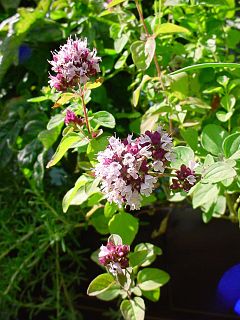Oregano
| Oregano | |
|---|---|

| |
| Flowering oregano | |
| Scientific classification | |
| Kingdom: | |
| Division: | |
| Class: | |
| Order: | |
| Family: | |
| Genus: | |
| Species: | O. vulgare
|
| Binomial name | |
| Origanum vulgare | |
Oregano or Pot Marjoram (Origanum vulgare) is a species of Origanum, native to Europe, the Mediterranean region and southern and central Asia. It is a perennial herb, growing to 20-80 cm tall, with opposite leaves 1-4 cm long. The flowers are purple, 3-4 mm long, produced in erect spikes.
Cultivation and uses

Oregano is an important culinary herb. It is particularly widely used in Greek and Italian cuisines. It is the leaves that are used in cooking, and the dried herb is often more flavourful than the fresh.
It is a conditio sine qua non in Italian cuisine. It is used in tomato sauces, fried vegetables and grilled meat. Together with basil, it makes up for the character of Italian dishes; see parsley on Italian variants of bouquet garni.
Oregano combines nicely with pickled olives, capers and lovage leaves. Unlike most Italian herbs, oregano works with hot and spicy food, which is popular in southern Italy.
Oregano is an indispensable ingredient for Greek cuisine. Oregano adds flavour to the Greek salad and is usually used separately or added to the lemon-olive oil sauce that accompanies almost every fish or meat barbecues and some casseroles.
It has an aromatic, warm and slightly bitter taste. It varies in intensity; good quality is so strong that it almost numbs the tongue, but the cultivars adapted to colder climates have often unsatisfactory flavour. The influence of climate, season and soil on the composition of the essential oil is greater than the difference between the various species.
The related species Origanum onites (Greece, Asia Minor) and O. heracleoticum (Italy, Balkan peninsula, West Asia) have similar flavours. A closely related plant is marjoram from Asia Minor, which, however, differs significantly in taste, because phenolic compounds are missing in its essential oil. Some breeds show a flavour intermediate between oregano and marjoram (gold marjoram = gold oregano)
- Pizza
The dish most associated with oregano is pizza, an open pie of bread dough baked with a top of tasty ingredients. Its relatives have probably been eaten in Southern Italy for centuries. According to the legend, the first pizza was made in 1889 when King Umberto and his wife Margherita sojourned in Napoli (Naples). At this time, white bread flavoured with tomato paste was a popular food for the poor masses. To honour the Queen, a local baker devised a richer pie. In addition to the red tomato paste, white mozzarella cheese and green basil leaves were employed to reflect the colours of the Italian flag. This invention became known as pizza Margherita and spread all over Italy and now, over the rest of the world.
Today's pizza relies more on oregano than on basil, and use a multitude of further ingredients: Ham, sausage, shellfish, mushrooms, artichokes, onion, garlic, olives, capers, anchovies and more make pizza a sophisticated delicacy, although it had once been the poor man's sandwich.
- Mexican dishes
The very similar, but stronger, taste of Mexican oregano (see below) is popular not only in its native country Mexico, but also in the south of the U.S., where it is frequently used to flavour chili con carne (meat stewed with chiles and sometimes beans) or other Mexico-inspired dishes like Pozole. For this purpose, it is mostly combined with several varieties of chillies and paprika, dried garlic or onion and cumin.
Health benefits
Oregano is high in antioxidant activity, particularly due to a high content of phenolic acids and flavonoids (PMID 16218659, PMID 12730411). Additionally, oregano has demonstrated antimicrobial activity against food-borne pathogens such as Listeria monocytogenes (PMID 16218659). Both of these characteristics may be useful in both health and food preservation. In the Philippines, oregano is not commonly used for cooking but is rather considered as a primarily medicinal plant, useful for relieving children's coughs.
Other plants called oregano
Mexican Oregano stems from the plant Lippia graveolens (Verbenaceae) and is closely related to lemon verbena. It is a highly studied herb that is said to be of some medical use and is common in curandera female shamanic practices in Mexico and the Southwestern United States. Although only loosely related to oregano, Mexican Oregano has a very similar flavour, albeit stronger. It is increasingly traded, especially in the United States. Its strong aroma makes it an acceptable substitute for epazote leaves if the latter are not available; this wouldn't work the other way round, though.
There is a significant taxonomic confusion about the term "oregano" in Mexican cooking. Several plants are named thus in different parts of Mexico, and there is little clear information about those. Some plants that have been identified as "Mexican Oregano" are Poliomintha longiflora, Lippia berlandieri, and Plectranthus amboinicus (syn. Coleus aromaticus), also called Cuban oregano.
In dried form, oregano bears a similar appearance to marijuana. A popular urban legend is the story of an inexperienced person unwittingly purchasing the spice from an unscrupulous dealer instead of the drug. Oregano was used as a euphemism for marijuana in the movie A Few Good Men, when Tom Cruise's character is told that "oregano" helps fear of flying.
